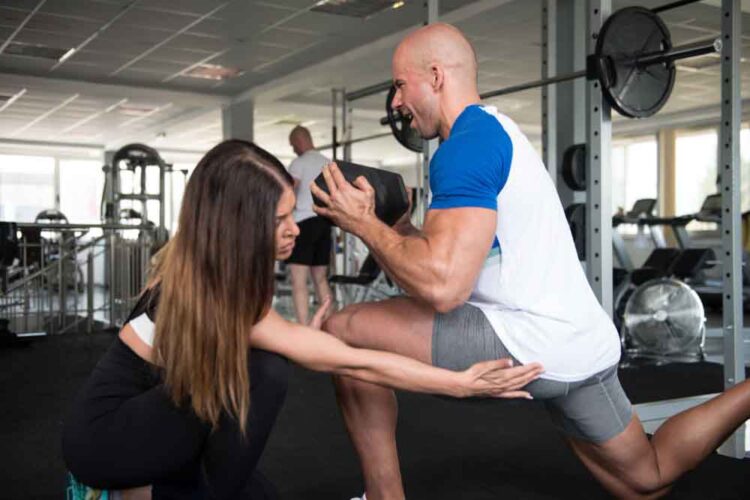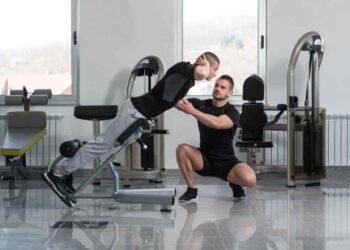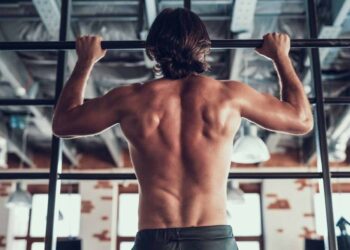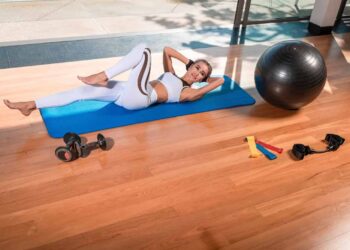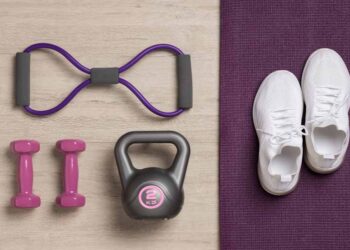Are you ready to sculpt your glutes into rock-hard, head-turning assets? Say goodbye to a saggy bottom and hello to a strong and toned backside that commands attention. Think you know everything there is to know about glute training? Think again! We’re about to challenge common beliefs and dive deep into the world of glutes exercises and workouts that will take your booty game to the next level.
Whether you’re a fitness enthusiast looking to enhance your overall strength and performance, or you simply want to feel more confident in your tight jeans, building stronger glutes should be a top priority. But where do you start? What are the best glutes workouts? And can you really strengthen your glutes without hitting the gym?
Join us on a journey to discovering the secrets of glute activation, effective exercises, and game-changing workouts that will leave you with glutes of glory! Get ready to unleash the power of your posterior chain and let those glutes shine.
Key Takeaways:
- Building stronger glutes is crucial for overall strength and fitness.
- Glute training benefits both men and women.
- Glute-specific exercises can be incorporated into leg training for optimal results.
- Unilateral training can effectively target lagging glutes and prevent muscular imbalances.
- Variety in exercises is key to stimulating glute development.
Double Up Your Leg Training
Incorporating glute-specific exercises into your leg training can help you target and strengthen your glutes. Squats, deadlifts, lunges, and hip thrusts are great compound exercises that engage multiple muscle groups, including the glutes. To prioritize glute development, consider having two leg days per week – one focused on overall leg training and the other with extra emphasis on glute-specific cues. This approach can lead to significant progress in building stronger glutes.
Targeting the Glutes
When it comes to leg training, it’s important to include exercises that directly target the glutes. Squats, especially with a wider stance, activate the glutes more effectively. Engage your glutes during deadlifts by focusing on squeezing them at the top of the movement. Lunges and step-ups can be modified to emphasize the glutes by taking longer strides or elevating the back foot. Hip thrusts are a great exercise that specifically targets the glutes, so be sure to include them in your routine.
Glute-Specific Cues
In addition to incorporating glute-specific exercises, it’s important to focus on proper form and technique to fully activate the glutes. When performing squats and lunges, drive through your heels and engage your glutes on the way up. Squeeze your glutes at the top of each repetition during exercises like deadlifts and hip thrusts. By using glute-specific cues, you can maximize glute recruitment and make each leg training session more effective.
“Incorporating glute-specific exercises into your leg routine is crucial for building stronger glutes.”
By doubling up your leg training and including glute-specific exercises, you can effectively target and strengthen your glutes. Remember to focus on proper form and technique, utilizing glute-specific cues to engage your glute muscles. With consistency and dedication, you’ll be well on your way to achieving a stronger, firmer backside.
Train One Leg At A Time
Unilateral training, which involves training each limb independently, can be highly effective in targeting lagging body parts, including the glutes. By focusing on one leg at a time, you can address muscular imbalances and activate more glute muscles. One-legged deadlifts using dumbbells are a great exercise to incorporate into your glute training routine.
The one-legged deadlift is a compound movement that not only targets the glute muscles but also engages the hamstrings and core. It requires balance, stability, and coordination, making it a challenging exercise that yields great results.
During a one-legged deadlift, focus on maintaining a neutral spine and hinging at the hips. Hold a dumbbell in one hand and lift the opposite leg off the ground while keeping it straight. Slowly lower the dumbbell towards the floor, feeling the stretch in the hamstring of the lifted leg, and then return to the starting position.
The one-legged deadlift helps improve the mind-muscle connection and ensures each limb is putting forth an equal amount of work. This reduces the risk of muscular imbalances and improves overall strength and stability.
Benefits of Unilateral Training for Glutes
- Targets lagging glutes and corrects muscular imbalances
- Improves mind-muscle connection and activation
- Enhances balance, stability, and coordination
- Builds overall strength and stability in the lower body
- Prevents asymmetrical development and reduces the risk of injury
Integrating unilateral training, such as one-legged deadlifts, into your glute training routine can take your workouts to the next level. It’s an efficient way to maximize glute activation and address any muscular imbalances that may hinder your progress.
| Exercise | Primary Muscles Targeted | Equipment |
|---|---|---|
| One-Legged Deadlifts | Glutes, Hamstrings, Core | Dumbbells |
| Pistol Squats | Glutes, Quadriceps, Hamstrings | Bodyweight, Dumbbells |
| Lunges | Glutes, Quadriceps, Hamstrings | Dumbbells, Barbell |
| Step-Ups | Glutes, Quadriceps, Hamstrings | Box, Bench |
Hit Your Butt With The Kitchen Sink
When it comes to glute-focused leg day, variety is key. Incorporating a variety of glute exercises into your routine can help you target your glutes from different angles and maximize your glute gains. By mixing and matching exercises that target your lower body and glutes, including forward, reverse, and lateral movements, you can stimulate your glutes and prevent boredom in your workouts.
A glute-focused leg day should include a combination of compound exercises and isolation exercises to effectively work your glutes. Compound exercises such as squats, deadlifts, and lunges engage multiple muscle groups, including the glutes. Isolation exercises such as hip thrusts, glute bridges, and donkey kicks specifically target the glute muscles.
Here are some glute exercises you can include in your glute-focused leg day:
- Squats
- Deadlifts
- Lunges
- Hip thrusts
- Glute bridges
- Donkey kicks
- Fire hydrants
- Step-ups
- Side lunges
By incorporating a variety of glute exercises into your routine, you can target different areas of your glutes and ensure all aspects of your glute muscles are being worked. This will help you build a stronger, firmer butt and improve your overall lower body strength.
Remember to always maintain proper form and technique during your glute exercises to avoid injury and get the most out of your workouts. If you’re not sure how to perform a certain exercise, consider seeking guidance from a qualified fitness professional.
So, don’t be afraid to hit your butt with the kitchen sink and try out a variety of glute exercises on your glute-focused leg day. Your glutes will thank you!
What Are The Best Rep Ranges For Glute Training?
When it comes to training your glutes, incorporating a variety of rep ranges can optimize your workout effectiveness. Similar to training other muscle groups, varying your rep ranges can target different aspects of glute development, from strength to hypertrophy and endurance. By strategically mixing and matching rep ranges or dedicating specific days to different training goals, you can enhance your glute training and achieve better results.
Strength Training: 5 or Less Reps
Training with lower reps, typically 5 or less, is a great way to build strength in your glutes. This rep range allows you to lift heavier weights, challenging your muscles and stimulating strength gains. Compound exercises like barbell squats and deadlifts are often performed with lower reps, emphasizing the recruitment of more muscle fibers, including the glutes, and promoting overall strength development.
Moderate Reps: 6-8 Reps
For those who want to focus on both strength and hypertrophy, performing moderate reps in the range of 6 to 8 can be beneficial. This rep range strikes a balance between heavy weight and muscle volume, stimulating both strength and muscle growth. By incorporating exercises like lunges, step-ups, and hip thrusts, you can challenge your glutes and stimulate muscle development.
Higher Reps: 8-12 Reps
If you’re aiming for muscle hypertrophy and a pump effect in your glutes, consider incorporating higher reps, typically in the range of 8 to 12. This rep range promotes increased blood flow to the muscles, creating a hypertrophic response and giving your glutes a fuller appearance. Exercises like glute bridges, cable kickbacks, and donkey kicks can be performed with higher reps to achieve the desired muscle pump.
Very High Reps: 12 or More Reps
To target hypertrophy and endurance in your glutes, incorporating very high reps, 12 or more, can be effective. Using lighter weights or bodyweight exercises, performing exercises like clamshells, fire hydrants, and lateral band walks with high reps can further fatigue the glute muscles and promote endurance. This rep range challenges your glutes to perform for an extended period, improving their ability to sustain long-duration activities.
By strategically incorporating different rep ranges into your glute training routine, you can ensure overall development and maximize your training efforts. Whether it’s building strength, promoting muscle growth, or enhancing endurance, varying your rep ranges is key to achieving glutes of glory!
Go In Prepared
Before diving into your glute-focused workout, it is crucial to be prepared. By having a game plan and knowing which exercises you will be performing, you can make the most out of your training session.
Fueling your body properly is another essential aspect of workout preparation. Prior to your training session, consider consuming a balanced meal that consists of fast-digesting protein and carbohydrates. This combination will provide the necessary energy to fuel your muscles and optimize your performance.
In addition to proper nutrition, incorporating a pre-workout supplement on your leg days can give you an extra boost and enhance your focus and endurance. With the right fuel and a pre-workout supplement, you can power through your glute workout with intensity and determination.
By adhering to these preparatory steps, you can ensure that your body is ready to take on the challenges of a glute-focused workout, ultimately leading to better results and gains.
| Workout Preparation Checklist |
|---|
| Have a plan in mind for your glute-focused exercises |
| Fuel your body with a meal containing fast-digesting protein and carbs |
| Consider using a pre-workout supplement to enhance performance |
Squat Wide, Go Deep
Incorporating proper techniques and variations is essential when targeting the glutes during lower body exercises like squats. By adjusting foot positions and squat depth, you can effectively engage your glutes and maximize your workout.
Foot Position
When performing squats, your foot position plays a crucial role in activating the glutes. By adopting a wider stance, you can shift the focus onto your glutes. This variation forces your glutes to work harder to stabilize and power through the movement. Alternatively, kicking your feet out in front during barbell squats can also put additional emphasis on the glutes.
Squat Depth
The depth of your squats greatly influences glute activation. For optimal results, aim to go down to at least 90 degrees, ensuring that your knees are adequately bent. This range allows for proper engagement of the glute muscles, activating them more effectively. Remember to maintain proper form and control throughout the entire range of motion.
Implementing these adjustments to your squats can help you target and strengthen the glute muscles, leading to better overall glute development and performance.
By adjusting foot positions and squat depth, you can effectively engage your glutes and maximize your workout.
Conclusion
To achieve stronger and firmer glutes, it’s crucial to prioritize glute training in your fitness routine. Building a strong backside not only enhances your physical appearance but also improves your overall strength, stability, and body composition. Incorporating a variety of glute exercises is key to targeting different muscles and maximizing your results.
When performing glute exercises, focus on maintaining proper form and technique. This ensures that your glutes are effectively engaged and prevents the risk of injury. Challenge yourself by incorporating different rep ranges into your workouts, including lower reps for strength, moderate reps for strength and hypertrophy, and higher reps for hypertrophy and endurance.
Consistency and dedication are essential in achieving your glutes goals. Stay committed to your glute training program and make it a regular part of your fitness routine. With time, patience, and the right exercises, you can achieve glutes of glory that will not only make you feel confident and strong but also improve your overall fitness performance.
Remember, building stronger glutes is a journey that requires effort and dedication. Stay motivated, stay focused, and enjoy the process of transforming your backside into a powerful asset. Incorporate the knowledge and strategies shared in this article, and you’ll be well on your way to achieving strong, firm, and enviable glutes!

